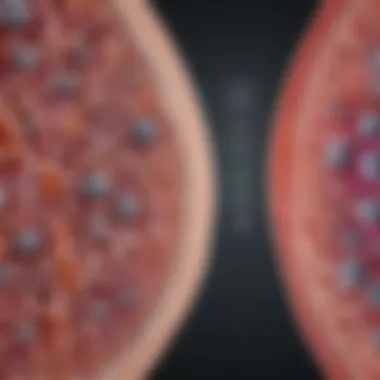Calcium Levels and Their Impact on Small Cell Lung Cancer


Intro
The relationship between calcium levels and small cell lung cancer (SCLC) has gained attention in recent years. Understanding this connection is vital for advancing treatment strategies and improving patient outcomes. Calcium is not only a basic mineral essential for bone health, but it also plays a critical role in various cellular processes. These processes might influence cancer cell behavior, including growth, survival, and response to therapies. By examining the nuances of calcium metabolism in the context of SCLC, we can identify potential pathways for intervention and therapeutic advancements.
Recent Advances
Latest Discoveries
Recent studies have shown that altered calcium homeostasis can significantly impact SCLC progression. Research indicates that SCLC cells often exhibit disrupted calcium signaling pathways. For instance, certain ion channels like TRPC (transient receptor potential canonical) channels have been implicated in these processes. These channels modulate intracellular calcium, which affects tumor cell migration and invasion. Some studies even suggest that targeting these channels can inhibit tumor growth and metastasis.
Additionally, elevated extracellular calcium levels have been associated with enhanced proliferation of SCLC cells. This relationship raises questions about how calcium-rich environments affect tumor behavior. More research is needed to clarify these findings and their potential implications for therapy.
Technological Innovations
The exploration of calcium's role in SCLC has also benefitted from technological advancements. Techniques such as single-cell calcium imaging have allowed researchers to observe real-time calcium dynamics within cancer cells. This capability helps to unravel the complexities of how SCLC cells interact with their environment and respond to treatment.
Genomic and proteomic approaches continue to evolve, enabling scientists to profile calcium-related proteins and genes in SCLC. These innovations are paving the way for personalized medicine, where treatments could be tailored based on individual calcium metabolism profiles.
"The intricate interplay between calcium levels and cancer pathways underscores the importance of integrative approaches in oncology."
Methodology
Research Design
To establish a clearer understanding of how calcium levels influence SCLC, researchers employ a range of methodologies. Many studies utilize comparative analyses between normal lung tissue and SCLC samples. Studies often leverage both in vitro and in vivo models to dissect the underlying mechanisms by which calcium affects cancer cell behavior.
Data Collection Techniques
Data collection in these studies typically involves a combination of laboratory assays and advanced imaging techniques. Common methods include:
- Fluorescence microscopy for observing calcium signaling.
- Western blotting to analyze calcium-related protein expression.
- Flow cytometry for quantifying cellular responses to calcium modulation.
These techniques enable researchers to collect empirical evidence supporting the interplay between calcium levels and SCLC dynamics.
Understanding the effects of calcium on SCLC can provide profound insights into treatment approaches. The results of ongoing research will likely refine our comprehension of this topic, fostering an environment conducive to innovative therapeutic strategies.
Preface to Small Cell Lung Cancer
The exploration of small cell lung cancer (SCLC) stands as a critical area in oncology, given its aggressive nature and unique biological characteristics. This section highlights the importance of understanding SCLC, its definitions, epidemiology, and histological traits. Such knowledge forms the foundation for discussing the interplay between calcium levels and this cancer type.
Understanding SCLC not only aids in recognizing the challenges in treatment but also emphasizes how variables such as calcium levels might influence disease progression and patient outcomes.
Definition and Overview of SCLC
Small cell lung cancer is a highly malignant type of lung cancer characterized by the small size of its cancer cells. It typically originates in the bronchi and is closely associated with smoking. The disease is often divided into two stages: limited and extensive. In the limited stage, the cancer is confined to one hemithorax, whereas in the extensive stage, it has spread beyond this area.
SCLC is noted for its rapid growth and early metastasis. Prognosis is generally poor due to these factors. Common symptoms include cough, chest pain, shortness of breath, and systemic symptoms such as weight loss. The treatment usually involves chemotherapy and radiation, although research into targeted therapies is ongoing.
Epidemiology and Risk Factors
Epidemiological studies show that small cell lung cancer accounts for approximately 15% of all lung cancer cases. It predominantly affects older adults, with a median diagnosis age around 65 years. While smoking remains the primary risk factor, with over 90% of patients having a history of tobacco use, other factors also come into play.


Risk factors such as exposure to radon gas, asbestos, and certain industrial chemicals can increase susceptibility. Additionally, a family history of lung cancer may elevate risk. Understanding these epidemiological aspects enables researchers and clinicians to identify individuals at higher risk and tailor preventative strategies accordingly.
Histological Characteristics
The histological examination of small cell lung cancer reveals a distinct appearance. The cells are small, oval, and have scant cytoplasm, with high nuclear-to-cytoplasmic ratios. Histologically, SCLC is categorized into two subtypes: classic and variant. Classic SCLC displays the typical small cell morphology, whereas variant types exhibit more diverse histological features.
Histological characteristics aid in diagnosing and determining the prognosis for SCLC patients. The presence of neuroendocrine differentiation is also a salient feature, which may influence treatment response and outcomes. Additionally, these pathological aspects underscore the importance of calcium signaling pathways, which could play a role in cell proliferation and survival in SCLC.
"Understanding the histological characteristics of small cell lung cancer provides critical insights into potential therapeutic targets."
In summary, this section lays the groundwork for a detailed discussion on how calcium levels may influence SCLC progression and treatment. The interrelation of calcium, physiology, and cancer biology represents a modern frontier in the quest for more effective therapies.
The Role of Calcium in Human Physiology
Calcium is an essential ion in human physiology, playing a critical role in various biological processes. Its importance extends beyond just bone health; calcium participates in muscle contraction, neurotransmitter release, and various cellular signaling pathways. A healthy calcium balance is vital for maintaining physiological functions and overall health.
Calcium Homeostasis
Calcium homeostasis refers to the regulation of calcium levels in the body. This involves a complex interplay between bones, kidneys, and the gastrointestinal tract. Parathyroid hormone (PTH), calcitonin, and vitamin D are key players in this regulatory process.
- Bone: Acts as the major reservoir for calcium. When serum calcium is low, PTH is released, stimulating bone resorption to release calcium into the bloodstream.
- Kidneys: Reabsorb calcium as needed, reducing its excretion in urine when levels are low.
- Intestines: Calcium absorption occurs in the intestines, facilitated by vitamin D. If dietary intake is insufficient, calcium levels may decline, leading to potential dysfunction.
Maintaining calcium homeostasis is crucial for preventing disorders like osteoporosis and cardiovascular problems.
Calcium Signaling Pathways
Calcium plays a pivotal role in cellular signaling pathways. It acts as a second messenger in various signal transduction pathways that affect numerous cellular functions. When calcium levels rise, they trigger pathways that can lead to cellular responses such as proliferation, differentiation, and apoptosis.
Some notable pathways include:
- Calcium/calmodulin-dependent protein kinases (CaMKs): These kinases mediate various cellular processes, including gene expression and cellular metabolism.
- Protein kinase C (PKC): This enzyme requires calcium for its activation and is involved in cell growth and differentiation.
Dysregulation in calcium signaling can contribute to numerous diseases, including cancer. Understanding these pathways is critical for uncovering how calcium levels influence disease progression, particularly in small cell lung cancer.
Calcium in Cellular Function and Growth
Calcium is vital in influencing cellular function and promoting growth. Its involvement in muscle contractions, neuronal activity, and hormone secretion showcases its diverse roles. Moreover, calcium concentrations can affect cellular behaviors, such as adhesion, migration, and proliferation.
In cancer, aberrant calcium signaling often leads to uncontrolled cell growth. For instance, elevated intracellular calcium may enhance the proliferation of cancer cells, including those in small cell lung cancer.
Calcium's role extends to apoptosis. When calcium levels are excessively high within cells, it may trigger programmed cell death. This dual effect—supporting proliferation while also facilitating apoptosis—illustrates calcium's complex role in cellular dynamics.
Understanding calcium's multifaceted roles in cellular processes is crucial for researchers and clinicians focusing on small cell lung cancer. The dual nature of calcium's influence necessitates a nuanced perspective when considering treatment strategies.
Pathophysiology of Small Cell Lung Cancer
Understanding the pathophysiology of small cell lung cancer (SCLC) is vital for comprehending its aggressive nature and guiding treatment strategies. SCLC is characterized by rapid tumor growth, early metastasis, and a robust association with paraneoplastic syndromes. The intricate interplay between cancer biology and calcium levels adds another layer of complexity in SCLC, which may impact patient outcomes.
Molecular Mechanisms in SCLC
At the molecular level, SCLC is driven by genetic abnormalities often linked to tobacco smoke exposure. One of the cornerstone genetic mutations is in the TP53 gene, which encodes the p53 tumor suppressor protein. This protein plays a critical role in cellular responses to DNA damage. When mutated, it fails to regulate the cell cycle, leading to uncontrolled proliferation. Apart from p53, mutations in the RB1 gene and alterations in neuroendocrine signaling pathways also play a significant role in the development of SCLC.
Calcium signaling pathways are also crucial in SCLC. Calcium ions serve as vital second messengers in various cellular processes, including proliferation and apoptosis. Alterations in calcium homeostasis are evident in cancer cells, and aberrant calcium signaling can promote cell survival and growth in SCLC by influencing pathways that regulate cell cycle progression. For instance, the activation of calcium-dependent proteins can enhance transcription factors associated with tumor proliferation.


Tumor Microenvironment in SCLC
The tumor microenvironment surrounding SCLC cells is rich in supportive factors. It comprises various stromal cells, immune cells, and extracellular matrix components that facilitate tumor growth. These elements can influence calcium levels in the tumor area. Cancer-associated fibroblasts, for example, may release factors that increase local calcium concentrations, contributing to enhanced tumor viability and resilience.
Moreover, hypoxia in the tumor microenvironment can lead to increased calcium signaling, which further fosters tumor growth. SCLC cells adapt to oxygen depletion by modifying their metabolism, often resulting in increased intracellular calcium. This alteration may activate oncogenic signaling pathways and promote further malignancy.
Calcium and SCLC Cell Proliferation
Calcium’s role in cell proliferation in SCLC is complex yet critical. Elevated intracellular calcium levels can stimulate pathways that govern cell growth and division. Research indicates that the influx of calcium through specific ion channels, such as TRP channels, can contribute to cell cycle progression. This pathway allows cancer cells to exploit calcium for their advantage, making them more aggressive.
Additionally, calcium signaling is linked with apoptosis. In SCLC, decreased apoptotic activity may enhance tumor survival. Therefore, targeting calcium homeostasis may introduce novel therapeutic avenues. Manipulating calcium levels could inhibit tumor growth and sensitize SCLC to traditional therapies, like chemotherapy or radiation.
"Calcium signaling is a double-edged sword in cancer biology; while it can promote growth, it can also instigate apoptosis."
Calcium Levels and Cancer Progression
Understanding the relationship between calcium levels and cancer progression is essential in oncology. Calcium plays a multifaceted role in cellular functions, including signaling pathways that regulate cell growth and apoptosis. Small Cell Lung Cancer (SCLC), characterized by its aggressive nature, exhibits distinct interaction with calcium levels. Research indicates that abnormal calcium metabolism may significantly contribute to the growth and spread of SCLC cells. This section will explore how calcium impacts cancer progression, highlighting critical elements and implications for treatment.
Hypercalcemia in Cancer Patients
Hypercalcemia, a condition marked by elevated calcium levels in the blood, is a common complication in cancer patients. This phenomenon often arises due to either increased bone resorption or excessive parathyroid hormone-related peptide (PTHrP) secretion from tumors. Patients with SCLC may experience hypercalcemia, which can exacerbate symptoms and complicate treatment plans.
- Symptoms: These may include fatigue, nausea, confusion, and bone pain, which can significantly decrease the patient's quality of life.
- Connection to Cancer: Hypercalcemia can result from both bone metastases and the tumor’s direct influence on calcium metabolism. It indicates more advanced disease and often correlates with poorer prognosis in lung cancer patients.
Effective management of hypercalcemia not only alleviates symptoms but also supports the overall treatment regimen. Recognizing and addressing high calcium levels early can thus play a crucial role in patient care.
Calcium's Influence on Tumor Growth
Calcium ions serve as important secondary messengers in cellular signaling processes that contribute to tumor growth. In SCLC, aberrant calcium signaling can trigger pathways that lead to enhanced cell proliferation and survival. Studies show that higher intracellular calcium concentrations often correlate with increased cancer cell growth and resistance to therapies.
- Mechanisms: Calcium influences several pathways, including the activation of protein kinases and phosphatases, which affect gene expression related to cell cycle progression.
- Potential Interventions: Targeting calcium signaling pathways presents a promising therapeutic approach. Drugs that modulate calcium levels may enhance the efficacy of conventional cancer treatments, potentially leading to better outcomes for patients.
Calcium and Metastatic Behavior
The role of calcium is not limited to tumor initiation and growth; it extends to metastatic behavior of cancer cells. Elevated calcium levels can facilitate the epithelial-mesenchymal transition (EMT), a critical step in cancer metastasis. Through EMT, cancer cells acquire invasive properties and the ability to migrate to distant sites in the body.
- Impact on Invasiveness: Cancer cells with dysregulated calcium levels often exhibit enhanced invasive capabilities. They can detach from the primary tumor, invade surrounding tissues, and enter the bloodstream or lymphatic system.
- Research Insights: Understanding the link between calcium levels and metastasis may lead to novel strategies aimed at preventing spread and improving patient prognosis.
It is evident that calcium status significantly influences SCLC evolution, from initial tumor growth to metastatic spread. Therefore, a comprehensive understanding of calcium's role can inform both prognosis and treatment strategies in affected patients.
Clinical Implications of Calcium in SCLC
The clinical implications of calcium in small cell lung cancer (SCLC) are multifaceted. As a critical mineral that plays various roles in cellular processes, calcium's impact on SCLC extends beyond mere tumor growth. It intersects with patient management, disease monitoring, and treatment strategies. Understanding these clinical implications is essential for formulating effective interventions and improving patient outcomes.
Calcium as a Biomarker for Disease Monitoring
Calcium levels in the body can serve as a biomarker for monitoring disease progression in SCLC. Abnormal calcium levels, particularly hypercalcemia, have been observed in many cancer patients. Many studies indicate that elevated serum calcium could correlate with tumor burden and progression. Therefore, regular monitoring of calcium levels can provide insights into disease status. This can help oncologists assess treatment efficacy and adjust therapeutic approaches based on a patient's specific needs. For instance, if calcium levels fluctuate during treatment, it might indicate a change in tumor activity or response to therapy.
Key Points:
- Abnormal calcium levels can indicate tumor burden and response to treatment.
- Regular calcium monitoring aids in timely clinical decisions.


Calcium Modulation in SCLC Treatments
The modulation of calcium levels offers promising avenues for SCLC treatment. Altering calcium levels may enhance the effectiveness of existing therapies or reduce tumor viability. For example, some studies have suggested using bisphosphonates or denosumab to manage elevated calcium levels in cancer patients. By targeting calcium pathways, these agents may inhibit cancer cell proliferation or stimulate apoptosis in SCLC cells. Additionally, understanding the interaction between calcium levels and chemotherapeutic agents can guide the development of new protocols that optimize treatment outcomes.
Pharmacological Agents Influencing Calcium Levels
Several pharmacological agents directly influence calcium levels, which can be particularly relevant in the context of SCLC. These agents include calcium channel blockers, bisphosphonates, and calcitonin.
- Calcium Channel Blockers: These are used primarily to manage cardiovascular conditions. However, they may also have potential benefits in cancer treatment by altering calcium signaling in tumor cells.
- Bisphosphonates: Primarily used to combat bone metastases and related hypercalcemia, they play a role in inhibiting osteoclast activity, thus reducing calcium release from bones.
- Calcitonin: This hormone can help lower elevated calcium levels in the bloodstream, providing relief for patients experiencing hypercalcemia due to cancer.
Incorporating these agents into the treatment plans for SCLC could lead to better management of calcium-related complications, providing a more holistic approach to patient care.
Research Advances and Future Directions
The exploration of calcium levels in relation to small cell lung cancer (SCLC) is an evolving area of oncological research. Understanding how these calcium levels interact with cancer progression can lead to valuable insights about potential treatments and patient management strategies. Thus, this section provides a crucial examination of recent developments, possible therapeutic avenues, and innovative technologies that may shape the future understanding of SCLC and calcium dynamics.
Current Research Trends
Recent studies have focused on various aspects of calcium signaling in SCLC, particularly its role in cellular functions that contribute to tumor growth and metastasis. Some key trends in this research include:
- Calcium Signaling Pathways: Researchers are increasingly defining specific calcium signaling pathways involved in SCLC proliferation and survival. This has led to a better understanding of how calcium levels can affect tumor behavior.
- Hypercalcemia Studies: Clinical observations have highlighted the prevalence of hypercalcemia among cancer patients, including those with SCLC. Research is underway to assess the implications of this condition on treatment outcomes and overall survival.
- Calcium's Role as a Biomarker: Emerging studies are investigating calcium levels as a potential biomarker for detecting and monitoring disease progression in SCLC. This line of inquiry holds promise for enhancing the precision of treatment strategies and individualizing patient care.
These trends emphasize the necessity for continued exploration across multiple dimensions of calcium’s role in SCLC, which can lead to more accurate diagnostics and improved therapeutic protocols.
Potential for New Therapeutic Strategies
The intertwining of calcium levels and SCLC progression suggests multiple avenues for innovative therapeutic strategies. Potential strategies include:
- Calcium Modulation: Targeting calcium channels and related signaling pathways offers a novel approach to modifying calcium levels within tumor cells. Agents that can selectively alter calcium signaling may provide new means to inhibit tumor growth.
- Combination Therapies: Combining traditional chemotherapeutic agents with calcium-targeting drugs could enhance the efficacy of existing treatment protocols. Research is exploring how altered calcium levels can synergize with these agents to optimize therapeutic outcomes.
- Gene Therapy: Advances in gene editing technologies may allow for targeted modulation of calcium-related genes. This could potentially enable the correction of dysfunctional calcium signaling pathways that contribute to SCLC progression.
Exploring these strategies is essential for developing effective treatment protocols tailored to the unique biochemical milieu of SCLC.
Emerging Technologies in Calcium Research
The integration of cutting-edge technologies is revolutionizing the study of calcium dynamics in SCLC. Notable advancements include:
- CRISPR/Cas9 Gene Editing: This powerful tool allows for precise modification of genes involved in calcium signaling. By editing these genes, researchers can observe changes in cellular behavior and deduce the specific roles of calcium in SCLC biology.
- Calcium Imaging Techniques: Advances in imaging technologies, such as fluorescent calcium indicators, enable real-time observation of calcium dynamics within cells. This provides researchers with a clearer view of how calcium fluctuations influence SCLC progression.
- Big Data Analytics: Utilizing large datasets for analysis can uncover patterns in calcium metabolism associated with SCLC. Machine learning algorithms can aid in predicting outcomes based on calcium level variations and enhance the understanding of patient responses to treatment.
Ultimately, these innovative technologies hold tremendous potential for transforming the landscape of SCLC research and treatment, guiding future inquiries that can lead to more effective interventions.
Ending
The exploration of the relationship between calcium levels and small cell lung cancer (SCLC) has substantial implications. This article has highlighted pivotal aspects, such as the role of calcium in cellular functions and its influence on cancer progression. The connection between altered calcium metabolism and the biology of SCLC is not merely a scientific curiosity; it is a matter of clinical relevance.
Summary of Key Findings
Throughout this article, several critical findings have emerged:
- Calcium's Role in Cell Proliferation: Various studies indicate that calcium signals can enhance tumor growth and survival in SCLC cells.
- Hypercalcemia Prevalence: Many cancer patients, particularly those with SCLC, exhibit elevated calcium levels, which correlate with disease progression.
- Potential Biomarker: Calcium levels may serve as a useful biomarker for monitoring SCLC, offering insights into treatment efficacy.
- Research Trends: Advances in understanding calcium's role in SCLC open pathways for innovative therapeutic strategies aimed at targeting calcium metabolism.
These points underscore the importance of very meticulous study of calcium dynamics in the context of SCLC, pointing to a more nuanced understanding of this complex disease.
Implications for Future Research and Treatment
Research into calcium's implications in SCLC indicates many directions for future endeavors:
- Therapeutic Targeting: Targeting calcium signaling pathways could lead to more focused therapies. By doing so, it may be possible to impair the proliferation of SCLC cells driven by abnormal calcium levels.
- Understanding Mechanisms: Further exploration of the molecular mechanisms through which calcium influences tumor environments and metastasis in SCLC remains essential. This could enhance treatment strategies.
- Integration with Existing Treatments: There is a potential to incorporate calcium modulation into existing treatment protocols. Investigating how calcium influences responses to chemotherapy and radiation may open new avenues for improved patient outcomes.
The implications discussed here advocate for a multi-faceted approach in future research, encouraging both basic scientific inquiry and translational application. With the ongoing advancements in calcium research, it is clear that understanding its role in SCLC can pave the way for better diagnostic and therapeutic strategies, ultimately benefitting patient care.















